Advanced Taxation Law Answer 2022
VerifiedAdded on 2022/10/13
|13
|2728
|15
AI Summary
Contribute Materials
Your contribution can guide someone’s learning journey. Share your
documents today.

Running head: ADVANCED TAXATION LAW
Advanced Taxation Law
Name of the Student
Name of the University
Authors Note
Course ID
Advanced Taxation Law
Name of the Student
Name of the University
Authors Note
Course ID
Secure Best Marks with AI Grader
Need help grading? Try our AI Grader for instant feedback on your assignments.
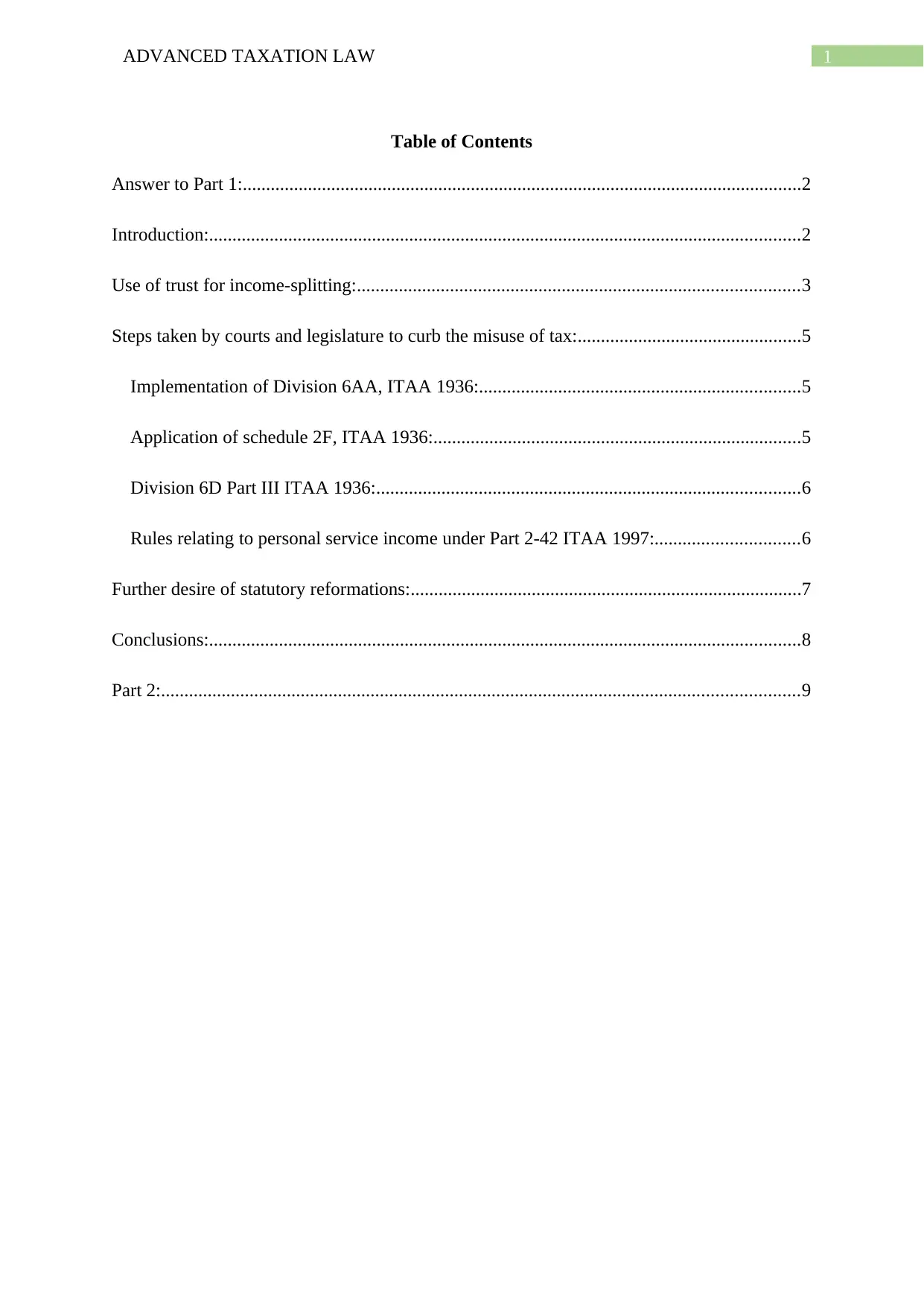
1ADVANCED TAXATION LAW
Table of Contents
Answer to Part 1:........................................................................................................................2
Introduction:...............................................................................................................................2
Use of trust for income-splitting:...............................................................................................3
Steps taken by courts and legislature to curb the misuse of tax:................................................5
Implementation of Division 6AA, ITAA 1936:.....................................................................5
Application of schedule 2F, ITAA 1936:...............................................................................5
Division 6D Part III ITAA 1936:...........................................................................................6
Rules relating to personal service income under Part 2-42 ITAA 1997:...............................6
Further desire of statutory reformations:....................................................................................7
Conclusions:...............................................................................................................................8
Part 2:.........................................................................................................................................9
Table of Contents
Answer to Part 1:........................................................................................................................2
Introduction:...............................................................................................................................2
Use of trust for income-splitting:...............................................................................................3
Steps taken by courts and legislature to curb the misuse of tax:................................................5
Implementation of Division 6AA, ITAA 1936:.....................................................................5
Application of schedule 2F, ITAA 1936:...............................................................................5
Division 6D Part III ITAA 1936:...........................................................................................6
Rules relating to personal service income under Part 2-42 ITAA 1997:...............................6
Further desire of statutory reformations:....................................................................................7
Conclusions:...............................................................................................................................8
Part 2:.........................................................................................................................................9
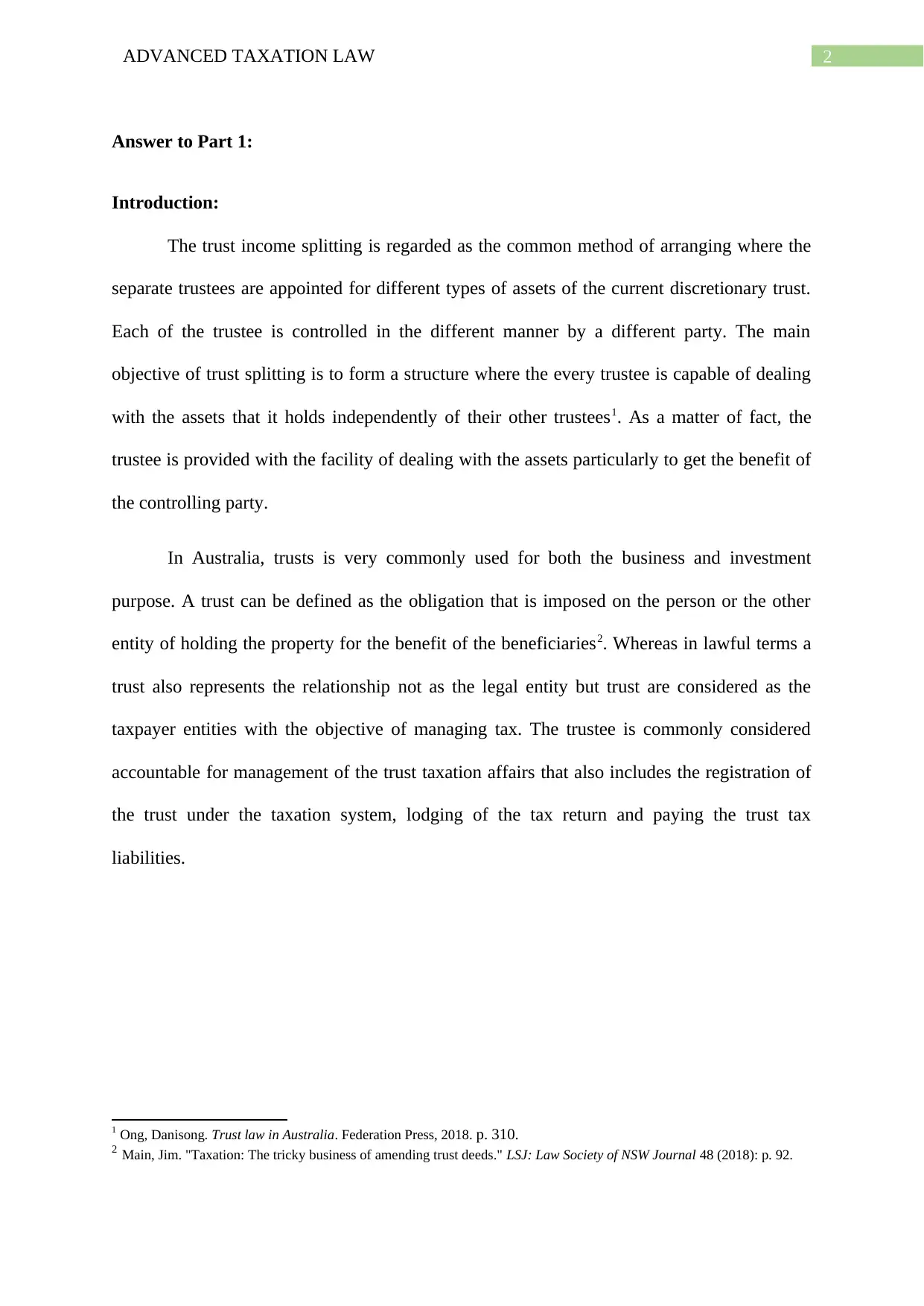
2ADVANCED TAXATION LAW
Answer to Part 1:
Introduction:
The trust income splitting is regarded as the common method of arranging where the
separate trustees are appointed for different types of assets of the current discretionary trust.
Each of the trustee is controlled in the different manner by a different party. The main
objective of trust splitting is to form a structure where the every trustee is capable of dealing
with the assets that it holds independently of their other trustees1. As a matter of fact, the
trustee is provided with the facility of dealing with the assets particularly to get the benefit of
the controlling party.
In Australia, trusts is very commonly used for both the business and investment
purpose. A trust can be defined as the obligation that is imposed on the person or the other
entity of holding the property for the benefit of the beneficiaries2. Whereas in lawful terms a
trust also represents the relationship not as the legal entity but trust are considered as the
taxpayer entities with the objective of managing tax. The trustee is commonly considered
accountable for management of the trust taxation affairs that also includes the registration of
the trust under the taxation system, lodging of the tax return and paying the trust tax
liabilities.
1 Ong, Danisong. Trust law in Australia. Federation Press, 2018. p. 310.
2 Main, Jim. "Taxation: The tricky business of amending trust deeds." LSJ: Law Society of NSW Journal 48 (2018): p. 92.
Answer to Part 1:
Introduction:
The trust income splitting is regarded as the common method of arranging where the
separate trustees are appointed for different types of assets of the current discretionary trust.
Each of the trustee is controlled in the different manner by a different party. The main
objective of trust splitting is to form a structure where the every trustee is capable of dealing
with the assets that it holds independently of their other trustees1. As a matter of fact, the
trustee is provided with the facility of dealing with the assets particularly to get the benefit of
the controlling party.
In Australia, trusts is very commonly used for both the business and investment
purpose. A trust can be defined as the obligation that is imposed on the person or the other
entity of holding the property for the benefit of the beneficiaries2. Whereas in lawful terms a
trust also represents the relationship not as the legal entity but trust are considered as the
taxpayer entities with the objective of managing tax. The trustee is commonly considered
accountable for management of the trust taxation affairs that also includes the registration of
the trust under the taxation system, lodging of the tax return and paying the trust tax
liabilities.
1 Ong, Danisong. Trust law in Australia. Federation Press, 2018. p. 310.
2 Main, Jim. "Taxation: The tricky business of amending trust deeds." LSJ: Law Society of NSW Journal 48 (2018): p. 92.

3ADVANCED TAXATION LAW
Use of trust for income-splitting:
Discretionary trust:
For the purpose of income splitting the taxpayers make use of the discretionary trust
for the purpose of tax planning34. This provides that throughout the lifespan of the trust, the
trustees has the unconstrained discretion which they never need to exercise for disposing the
income and capital among one or more members or the beneficiaries within such a proportion
that the trustee may decide as and when required5. Upon the conclusion of the maximum
lifespan of trust, the remaining amount of funds that are leftover is distributed based on the
direction of the trust instrument based on the respective shares within the identified class of
beneficiaries particularly the children of the settlor then living.
Income tax has been avoided by using the discretionary trust. This involves by
splitting the income among the family members that has lower income. Usually the income
splitting can be done in other manner but discretionary trust is mainly used as the ideal
structure for that purpose6. Trusts are also used for income splitting purpose where the
distribution of untaxed capital gains originating from the revaluations of assets inside the
discretionary trust to the beneficiaries does not result in capital gains. This usually helps the
taxpayers in circumventing capital gains tax.
Beneficiaries also get the tax breaks in the form of capital gains tax discount and
allowance through depreciation despite the fact that they does not have any control over the
3 Sterk, Stewart E., and Melanie B. Leslie. "Estates and Trusts: Cases and Materials." (2015) p. 156.
4 Barlow, John S., Lesley C. King, and Anthony G. King. Wills, administration and taxation law and practice. Sweet &
Maxwell, 2014 p. 215.
5 LEE, Jimmy Kiat Bee, et al. "Societal trust and corporate tax avoidance." (2014) p. 85.
6 Koumbiadis, Nicholas, et al. "Tax evasion and compliance; from the neo classical paradigm to behavioural economics, a
review." Journal of Accounting & Organizational Change (2014) p. 65.
Use of trust for income-splitting:
Discretionary trust:
For the purpose of income splitting the taxpayers make use of the discretionary trust
for the purpose of tax planning34. This provides that throughout the lifespan of the trust, the
trustees has the unconstrained discretion which they never need to exercise for disposing the
income and capital among one or more members or the beneficiaries within such a proportion
that the trustee may decide as and when required5. Upon the conclusion of the maximum
lifespan of trust, the remaining amount of funds that are leftover is distributed based on the
direction of the trust instrument based on the respective shares within the identified class of
beneficiaries particularly the children of the settlor then living.
Income tax has been avoided by using the discretionary trust. This involves by
splitting the income among the family members that has lower income. Usually the income
splitting can be done in other manner but discretionary trust is mainly used as the ideal
structure for that purpose6. Trusts are also used for income splitting purpose where the
distribution of untaxed capital gains originating from the revaluations of assets inside the
discretionary trust to the beneficiaries does not result in capital gains. This usually helps the
taxpayers in circumventing capital gains tax.
Beneficiaries also get the tax breaks in the form of capital gains tax discount and
allowance through depreciation despite the fact that they does not have any control over the
3 Sterk, Stewart E., and Melanie B. Leslie. "Estates and Trusts: Cases and Materials." (2015) p. 156.
4 Barlow, John S., Lesley C. King, and Anthony G. King. Wills, administration and taxation law and practice. Sweet &
Maxwell, 2014 p. 215.
5 LEE, Jimmy Kiat Bee, et al. "Societal trust and corporate tax avoidance." (2014) p. 85.
6 Koumbiadis, Nicholas, et al. "Tax evasion and compliance; from the neo classical paradigm to behavioural economics, a
review." Journal of Accounting & Organizational Change (2014) p. 65.
Secure Best Marks with AI Grader
Need help grading? Try our AI Grader for instant feedback on your assignments.

4ADVANCED TAXATION LAW
decisions relating to investment7. The beneficiaries does not has any risk related to fund and
may not know that they are the beneficiary. Unlawful dodging of tax and money laundering is
done by shifting the funds or splitting the income with the help of complex entity structures
to the overseas tax havens such as Switzerland.
The tax losses are transferred where the individuals are not involved directly in the
investment or business can obtain the benefit of related deductions8. There are also transfer of
income is made to the non-taxable entities particularly the charitable trusts which is
controlled directly by the same individuals that controls the private trusts. Regrettably, the
charitable funds are used by the wealthy individuals for the purpose of avoiding tax instead of
charitable purpose.
The ability of using the trust for income splitting among the family members is
completely dependent on the real terms of instrument based on which a particular trust is
created. For instance, discretionary family trust would commonly comprise of widely drafted
powers that would allow the trustees to make the discretionary distributions of income and
capital amid the beneficiaries of trust9.
Steps taken by courts and legislature to curb the misuse of tax:
Implementation of Division 6AA, ITAA 1936:
The implementation of “Division 6AA of the ITAA 1936” have addressed inequalities
within the taxation system that is created by the individuals to distribute income among the
7 Tan, Denise. "Discretionary trusts and landholder duty: Part 2." Taxation in Australia 53.8 (2019): p. 439.
8 Dowling, Grahame R. "The curious case of corporate tax avoidance: Is it socially irresponsible?." Journal of Business
Ethics 124.1 (2014): p. 173.
9 Hashimzade, Nigar, and Yuliya Epifantseva, eds. The Routledge companion to tax avoidance research. Routledge, 2017 p.
103.
decisions relating to investment7. The beneficiaries does not has any risk related to fund and
may not know that they are the beneficiary. Unlawful dodging of tax and money laundering is
done by shifting the funds or splitting the income with the help of complex entity structures
to the overseas tax havens such as Switzerland.
The tax losses are transferred where the individuals are not involved directly in the
investment or business can obtain the benefit of related deductions8. There are also transfer of
income is made to the non-taxable entities particularly the charitable trusts which is
controlled directly by the same individuals that controls the private trusts. Regrettably, the
charitable funds are used by the wealthy individuals for the purpose of avoiding tax instead of
charitable purpose.
The ability of using the trust for income splitting among the family members is
completely dependent on the real terms of instrument based on which a particular trust is
created. For instance, discretionary family trust would commonly comprise of widely drafted
powers that would allow the trustees to make the discretionary distributions of income and
capital amid the beneficiaries of trust9.
Steps taken by courts and legislature to curb the misuse of tax:
Implementation of Division 6AA, ITAA 1936:
The implementation of “Division 6AA of the ITAA 1936” have addressed inequalities
within the taxation system that is created by the individuals to distribute income among the
7 Tan, Denise. "Discretionary trusts and landholder duty: Part 2." Taxation in Australia 53.8 (2019): p. 439.
8 Dowling, Grahame R. "The curious case of corporate tax avoidance: Is it socially irresponsible?." Journal of Business
Ethics 124.1 (2014): p. 173.
9 Hashimzade, Nigar, and Yuliya Epifantseva, eds. The Routledge companion to tax avoidance research. Routledge, 2017 p.
103.
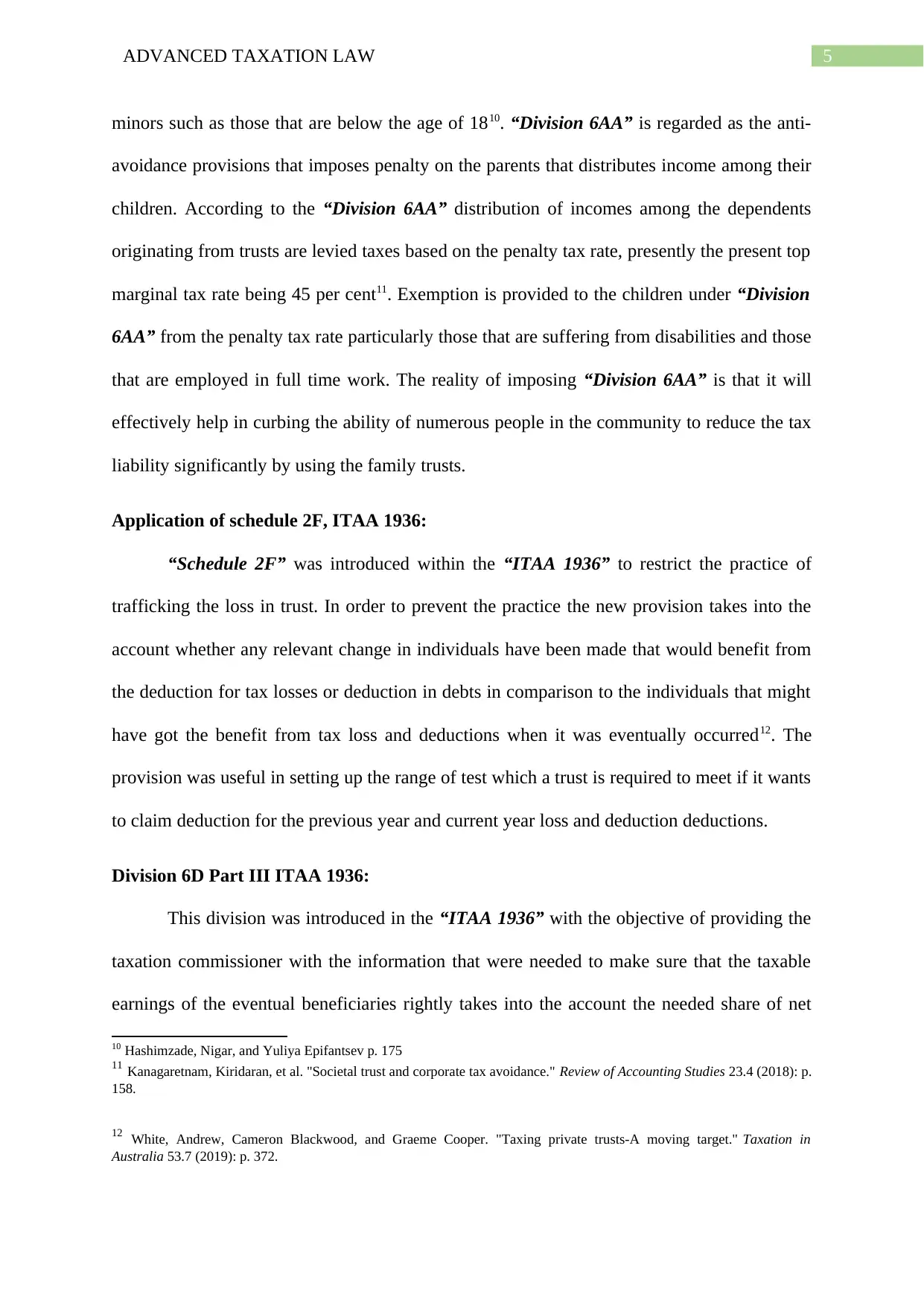
5ADVANCED TAXATION LAW
minors such as those that are below the age of 1810. “Division 6AA” is regarded as the anti-
avoidance provisions that imposes penalty on the parents that distributes income among their
children. According to the “Division 6AA” distribution of incomes among the dependents
originating from trusts are levied taxes based on the penalty tax rate, presently the present top
marginal tax rate being 45 per cent11. Exemption is provided to the children under “Division
6AA” from the penalty tax rate particularly those that are suffering from disabilities and those
that are employed in full time work. The reality of imposing “Division 6AA” is that it will
effectively help in curbing the ability of numerous people in the community to reduce the tax
liability significantly by using the family trusts.
Application of schedule 2F, ITAA 1936:
“Schedule 2F” was introduced within the “ITAA 1936” to restrict the practice of
trafficking the loss in trust. In order to prevent the practice the new provision takes into the
account whether any relevant change in individuals have been made that would benefit from
the deduction for tax losses or deduction in debts in comparison to the individuals that might
have got the benefit from tax loss and deductions when it was eventually occurred12. The
provision was useful in setting up the range of test which a trust is required to meet if it wants
to claim deduction for the previous year and current year loss and deduction deductions.
Division 6D Part III ITAA 1936:
This division was introduced in the “ITAA 1936” with the objective of providing the
taxation commissioner with the information that were needed to make sure that the taxable
earnings of the eventual beneficiaries rightly takes into the account the needed share of net
10 Hashimzade, Nigar, and Yuliya Epifantsev p. 175
11 Kanagaretnam, Kiridaran, et al. "Societal trust and corporate tax avoidance." Review of Accounting Studies 23.4 (2018): p.
158.
12 White, Andrew, Cameron Blackwood, and Graeme Cooper. "Taxing private trusts-A moving target." Taxation in
Australia 53.7 (2019): p. 372.
minors such as those that are below the age of 1810. “Division 6AA” is regarded as the anti-
avoidance provisions that imposes penalty on the parents that distributes income among their
children. According to the “Division 6AA” distribution of incomes among the dependents
originating from trusts are levied taxes based on the penalty tax rate, presently the present top
marginal tax rate being 45 per cent11. Exemption is provided to the children under “Division
6AA” from the penalty tax rate particularly those that are suffering from disabilities and those
that are employed in full time work. The reality of imposing “Division 6AA” is that it will
effectively help in curbing the ability of numerous people in the community to reduce the tax
liability significantly by using the family trusts.
Application of schedule 2F, ITAA 1936:
“Schedule 2F” was introduced within the “ITAA 1936” to restrict the practice of
trafficking the loss in trust. In order to prevent the practice the new provision takes into the
account whether any relevant change in individuals have been made that would benefit from
the deduction for tax losses or deduction in debts in comparison to the individuals that might
have got the benefit from tax loss and deductions when it was eventually occurred12. The
provision was useful in setting up the range of test which a trust is required to meet if it wants
to claim deduction for the previous year and current year loss and deduction deductions.
Division 6D Part III ITAA 1936:
This division was introduced in the “ITAA 1936” with the objective of providing the
taxation commissioner with the information that were needed to make sure that the taxable
earnings of the eventual beneficiaries rightly takes into the account the needed share of net
10 Hashimzade, Nigar, and Yuliya Epifantsev p. 175
11 Kanagaretnam, Kiridaran, et al. "Societal trust and corporate tax avoidance." Review of Accounting Studies 23.4 (2018): p.
158.
12 White, Andrew, Cameron Blackwood, and Graeme Cooper. "Taxing private trusts-A moving target." Taxation in
Australia 53.7 (2019): p. 372.
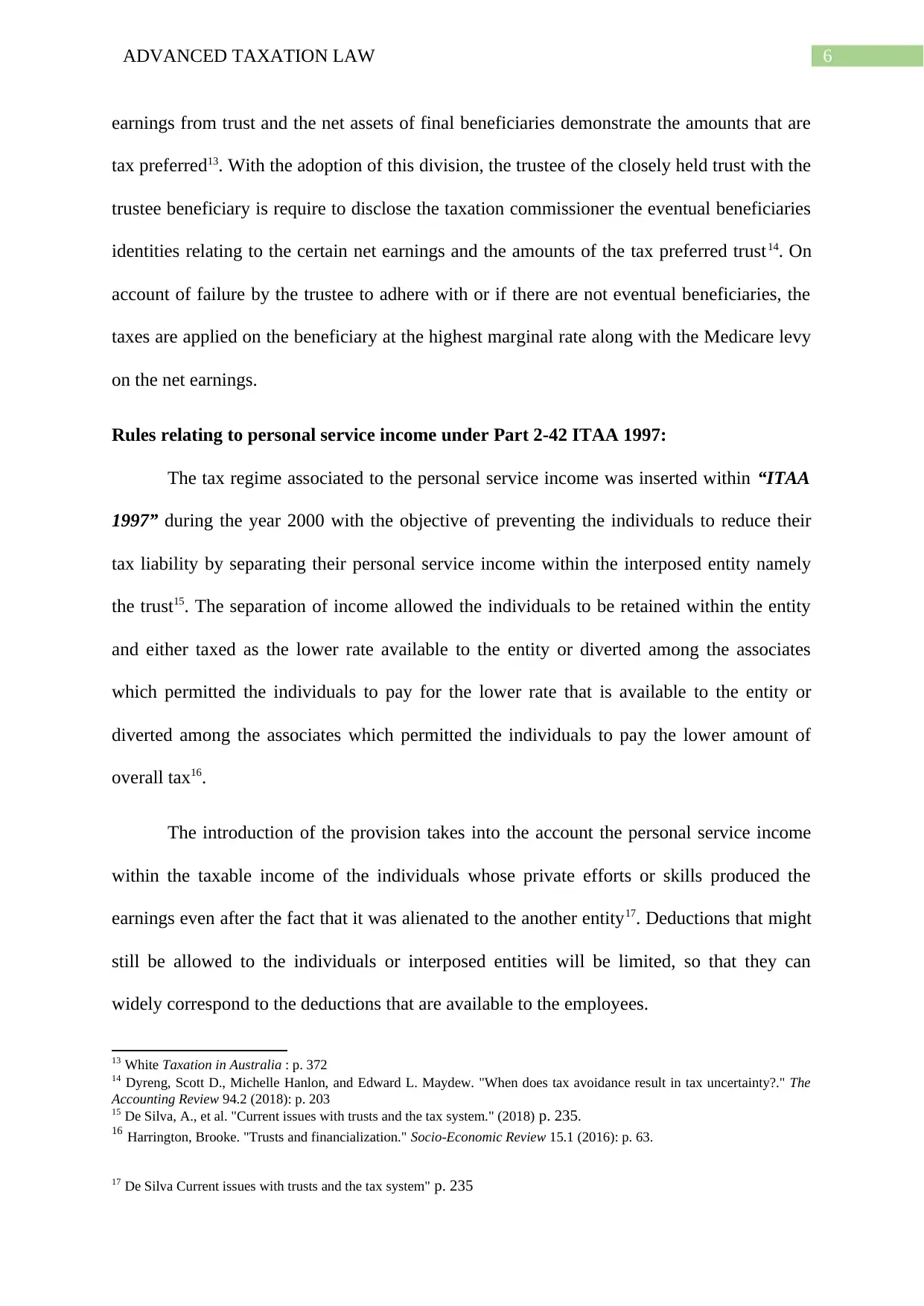
6ADVANCED TAXATION LAW
earnings from trust and the net assets of final beneficiaries demonstrate the amounts that are
tax preferred13. With the adoption of this division, the trustee of the closely held trust with the
trustee beneficiary is require to disclose the taxation commissioner the eventual beneficiaries
identities relating to the certain net earnings and the amounts of the tax preferred trust14. On
account of failure by the trustee to adhere with or if there are not eventual beneficiaries, the
taxes are applied on the beneficiary at the highest marginal rate along with the Medicare levy
on the net earnings.
Rules relating to personal service income under Part 2-42 ITAA 1997:
The tax regime associated to the personal service income was inserted within “ITAA
1997” during the year 2000 with the objective of preventing the individuals to reduce their
tax liability by separating their personal service income within the interposed entity namely
the trust15. The separation of income allowed the individuals to be retained within the entity
and either taxed as the lower rate available to the entity or diverted among the associates
which permitted the individuals to pay for the lower rate that is available to the entity or
diverted among the associates which permitted the individuals to pay the lower amount of
overall tax16.
The introduction of the provision takes into the account the personal service income
within the taxable income of the individuals whose private efforts or skills produced the
earnings even after the fact that it was alienated to the another entity17. Deductions that might
still be allowed to the individuals or interposed entities will be limited, so that they can
widely correspond to the deductions that are available to the employees.
13 White Taxation in Australia : p. 372
14 Dyreng, Scott D., Michelle Hanlon, and Edward L. Maydew. "When does tax avoidance result in tax uncertainty?." The
Accounting Review 94.2 (2018): p. 203
15 De Silva, A., et al. "Current issues with trusts and the tax system." (2018) p. 235.
16 Harrington, Brooke. "Trusts and financialization." Socio-Economic Review 15.1 (2016): p. 63.
17 De Silva Current issues with trusts and the tax system" p. 235
earnings from trust and the net assets of final beneficiaries demonstrate the amounts that are
tax preferred13. With the adoption of this division, the trustee of the closely held trust with the
trustee beneficiary is require to disclose the taxation commissioner the eventual beneficiaries
identities relating to the certain net earnings and the amounts of the tax preferred trust14. On
account of failure by the trustee to adhere with or if there are not eventual beneficiaries, the
taxes are applied on the beneficiary at the highest marginal rate along with the Medicare levy
on the net earnings.
Rules relating to personal service income under Part 2-42 ITAA 1997:
The tax regime associated to the personal service income was inserted within “ITAA
1997” during the year 2000 with the objective of preventing the individuals to reduce their
tax liability by separating their personal service income within the interposed entity namely
the trust15. The separation of income allowed the individuals to be retained within the entity
and either taxed as the lower rate available to the entity or diverted among the associates
which permitted the individuals to pay for the lower rate that is available to the entity or
diverted among the associates which permitted the individuals to pay the lower amount of
overall tax16.
The introduction of the provision takes into the account the personal service income
within the taxable income of the individuals whose private efforts or skills produced the
earnings even after the fact that it was alienated to the another entity17. Deductions that might
still be allowed to the individuals or interposed entities will be limited, so that they can
widely correspond to the deductions that are available to the employees.
13 White Taxation in Australia : p. 372
14 Dyreng, Scott D., Michelle Hanlon, and Edward L. Maydew. "When does tax avoidance result in tax uncertainty?." The
Accounting Review 94.2 (2018): p. 203
15 De Silva, A., et al. "Current issues with trusts and the tax system." (2018) p. 235.
16 Harrington, Brooke. "Trusts and financialization." Socio-Economic Review 15.1 (2016): p. 63.
17 De Silva Current issues with trusts and the tax system" p. 235
Paraphrase This Document
Need a fresh take? Get an instant paraphrase of this document with our AI Paraphraser
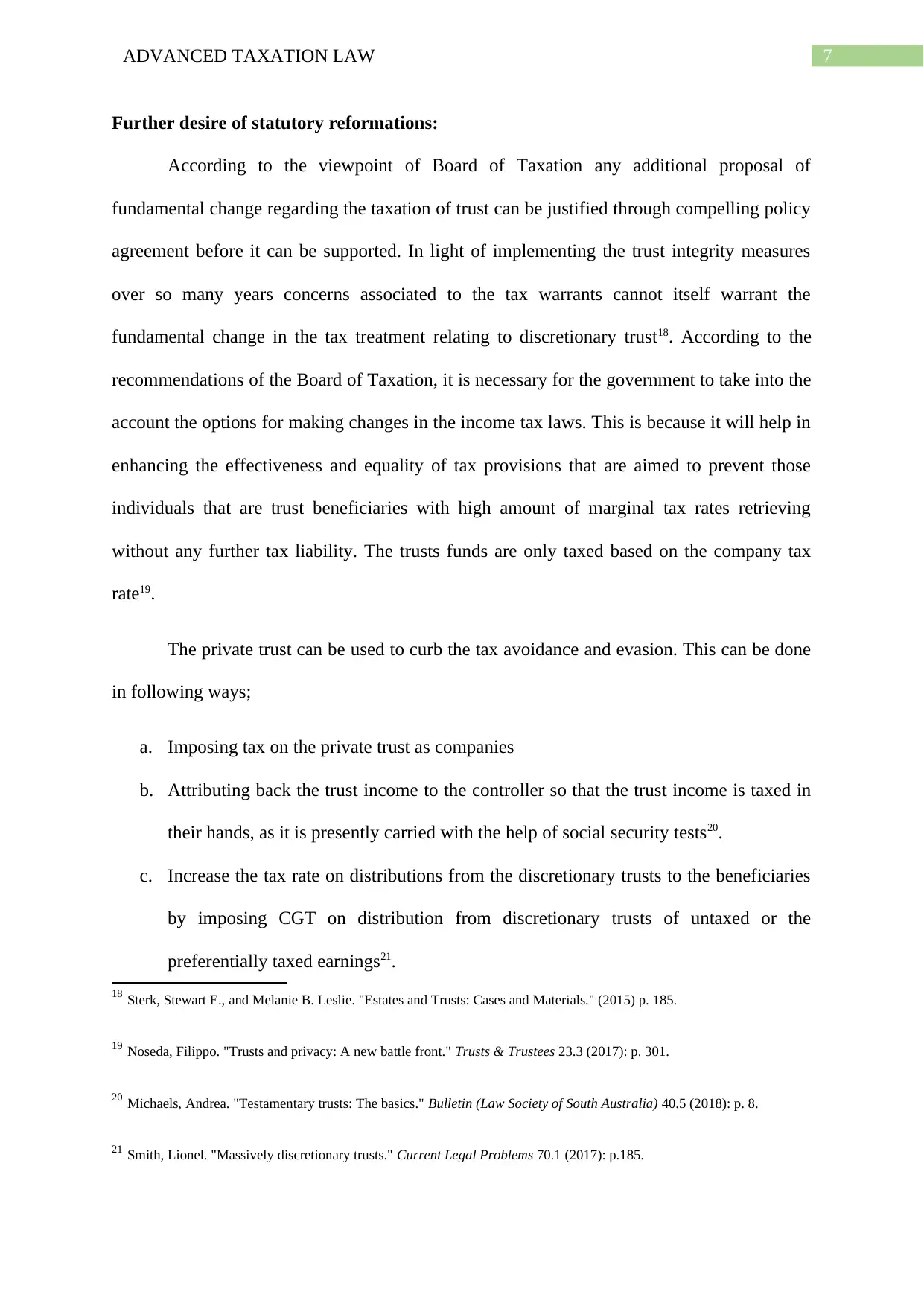
7ADVANCED TAXATION LAW
Further desire of statutory reformations:
According to the viewpoint of Board of Taxation any additional proposal of
fundamental change regarding the taxation of trust can be justified through compelling policy
agreement before it can be supported. In light of implementing the trust integrity measures
over so many years concerns associated to the tax warrants cannot itself warrant the
fundamental change in the tax treatment relating to discretionary trust18. According to the
recommendations of the Board of Taxation, it is necessary for the government to take into the
account the options for making changes in the income tax laws. This is because it will help in
enhancing the effectiveness and equality of tax provisions that are aimed to prevent those
individuals that are trust beneficiaries with high amount of marginal tax rates retrieving
without any further tax liability. The trusts funds are only taxed based on the company tax
rate19.
The private trust can be used to curb the tax avoidance and evasion. This can be done
in following ways;
a. Imposing tax on the private trust as companies
b. Attributing back the trust income to the controller so that the trust income is taxed in
their hands, as it is presently carried with the help of social security tests20.
c. Increase the tax rate on distributions from the discretionary trusts to the beneficiaries
by imposing CGT on distribution from discretionary trusts of untaxed or the
preferentially taxed earnings21.
18 Sterk, Stewart E., and Melanie B. Leslie. "Estates and Trusts: Cases and Materials." (2015) p. 185.
19 Noseda, Filippo. "Trusts and privacy: A new battle front." Trusts & Trustees 23.3 (2017): p. 301.
20 Michaels, Andrea. "Testamentary trusts: The basics." Bulletin (Law Society of South Australia) 40.5 (2018): p. 8.
21 Smith, Lionel. "Massively discretionary trusts." Current Legal Problems 70.1 (2017): p.185.
Further desire of statutory reformations:
According to the viewpoint of Board of Taxation any additional proposal of
fundamental change regarding the taxation of trust can be justified through compelling policy
agreement before it can be supported. In light of implementing the trust integrity measures
over so many years concerns associated to the tax warrants cannot itself warrant the
fundamental change in the tax treatment relating to discretionary trust18. According to the
recommendations of the Board of Taxation, it is necessary for the government to take into the
account the options for making changes in the income tax laws. This is because it will help in
enhancing the effectiveness and equality of tax provisions that are aimed to prevent those
individuals that are trust beneficiaries with high amount of marginal tax rates retrieving
without any further tax liability. The trusts funds are only taxed based on the company tax
rate19.
The private trust can be used to curb the tax avoidance and evasion. This can be done
in following ways;
a. Imposing tax on the private trust as companies
b. Attributing back the trust income to the controller so that the trust income is taxed in
their hands, as it is presently carried with the help of social security tests20.
c. Increase the tax rate on distributions from the discretionary trusts to the beneficiaries
by imposing CGT on distribution from discretionary trusts of untaxed or the
preferentially taxed earnings21.
18 Sterk, Stewart E., and Melanie B. Leslie. "Estates and Trusts: Cases and Materials." (2015) p. 185.
19 Noseda, Filippo. "Trusts and privacy: A new battle front." Trusts & Trustees 23.3 (2017): p. 301.
20 Michaels, Andrea. "Testamentary trusts: The basics." Bulletin (Law Society of South Australia) 40.5 (2018): p. 8.
21 Smith, Lionel. "Massively discretionary trusts." Current Legal Problems 70.1 (2017): p.185.

8ADVANCED TAXATION LAW
d. Increasing the transparency by making it mandatory for the trustee to disclose the
identity of controller and the eventual beneficiaries of the private trusts. It is also
recommended to set up the public register for the trusts that could be perhaps
managed by the ATO22.
Conclusions:
Private trusts are considered as the dense investment and structures of trading.
Presently there are no such public register relating to private trust as it is for companies. In
spite of this, the ATO regularly falls short of necessary information as who is the actual
controller of the private trusts and who forms the eventual beneficiaries of the trusts. On a
conclusive note, wider transparency relating to income on private trusts together with their
income that controls them and their eventual benefits is necessary for strengthening tax
integrity and exposing the money laundering.
22 Sterk, Stewart E., and Melanie B. Leslie Estates and Trusts: Cases and Materials." p. 185
d. Increasing the transparency by making it mandatory for the trustee to disclose the
identity of controller and the eventual beneficiaries of the private trusts. It is also
recommended to set up the public register for the trusts that could be perhaps
managed by the ATO22.
Conclusions:
Private trusts are considered as the dense investment and structures of trading.
Presently there are no such public register relating to private trust as it is for companies. In
spite of this, the ATO regularly falls short of necessary information as who is the actual
controller of the private trusts and who forms the eventual beneficiaries of the trusts. On a
conclusive note, wider transparency relating to income on private trusts together with their
income that controls them and their eventual benefits is necessary for strengthening tax
integrity and exposing the money laundering.
22 Sterk, Stewart E., and Melanie B. Leslie Estates and Trusts: Cases and Materials." p. 185

9ADVANCED TAXATION LAW
Part 2:
Issues:
Whether the taxpayer will be considered taxable for income tax in Australia on the
dividend received and fees earned in Australia?
Laws:
As clarified in the “Taxation Ruling of TR 98/17” a large number of persons that are
coming to Australia are treated as Australian resident based on the definition that is given in
“subsection 6 (1), ITAA 1936”23. The ruling is applied on the individuals that are entering
Australia and also includes the person;
a. Migrants
b. Academics teaching or the students coming to Australia
c. Students that are studying in Australia
d. Visitors on holiday
e. Workers that are coming with pre-arrangement employment contracts.
Residency is held as the status of question of fact and it is also regarded as the main
eligibility criteria which ascertains an individual’s tax liability in Australia24. The liability of
taxation is usually ascertained on the yearly basis. As held in “FCT v Applegate (1979)”
events that are taking place following the income year may also help in ascertaining the
person’s residency status25.
23 Barkoczy, Stephen. "Foundations of taxation law 2016." OUP Catalogue (2016) p. 184.
24 FCT v Applegate (1979)
25 Sadiq, Kerrie. Australian Taxation Law Cases 2019. Thomson Reuters, 2019.
Part 2:
Issues:
Whether the taxpayer will be considered taxable for income tax in Australia on the
dividend received and fees earned in Australia?
Laws:
As clarified in the “Taxation Ruling of TR 98/17” a large number of persons that are
coming to Australia are treated as Australian resident based on the definition that is given in
“subsection 6 (1), ITAA 1936”23. The ruling is applied on the individuals that are entering
Australia and also includes the person;
a. Migrants
b. Academics teaching or the students coming to Australia
c. Students that are studying in Australia
d. Visitors on holiday
e. Workers that are coming with pre-arrangement employment contracts.
Residency is held as the status of question of fact and it is also regarded as the main
eligibility criteria which ascertains an individual’s tax liability in Australia24. The liability of
taxation is usually ascertained on the yearly basis. As held in “FCT v Applegate (1979)”
events that are taking place following the income year may also help in ascertaining the
person’s residency status25.
23 Barkoczy, Stephen. "Foundations of taxation law 2016." OUP Catalogue (2016) p. 184.
24 FCT v Applegate (1979)
25 Sadiq, Kerrie. Australian Taxation Law Cases 2019. Thomson Reuters, 2019.
Secure Best Marks with AI Grader
Need help grading? Try our AI Grader for instant feedback on your assignments.
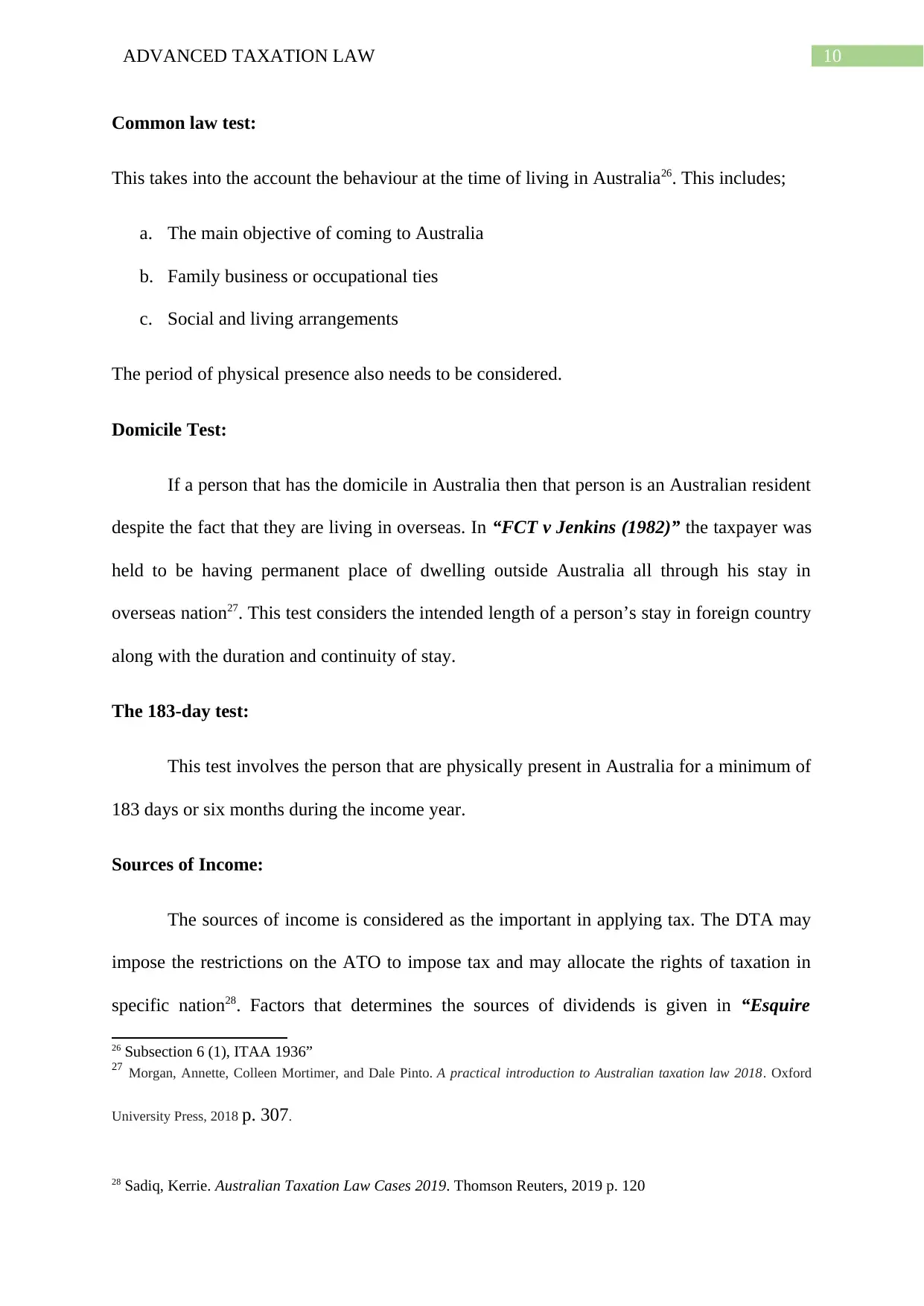
10ADVANCED TAXATION LAW
Common law test:
This takes into the account the behaviour at the time of living in Australia26. This includes;
a. The main objective of coming to Australia
b. Family business or occupational ties
c. Social and living arrangements
The period of physical presence also needs to be considered.
Domicile Test:
If a person that has the domicile in Australia then that person is an Australian resident
despite the fact that they are living in overseas. In “FCT v Jenkins (1982)” the taxpayer was
held to be having permanent place of dwelling outside Australia all through his stay in
overseas nation27. This test considers the intended length of a person’s stay in foreign country
along with the duration and continuity of stay.
The 183-day test:
This test involves the person that are physically present in Australia for a minimum of
183 days or six months during the income year.
Sources of Income:
The sources of income is considered as the important in applying tax. The DTA may
impose the restrictions on the ATO to impose tax and may allocate the rights of taxation in
specific nation28. Factors that determines the sources of dividends is given in “Esquire
26 Subsection 6 (1), ITAA 1936”
27 Morgan, Annette, Colleen Mortimer, and Dale Pinto. A practical introduction to Australian taxation law 2018. Oxford
University Press, 2018 p. 307.
28 Sadiq, Kerrie. Australian Taxation Law Cases 2019. Thomson Reuters, 2019 p. 120
Common law test:
This takes into the account the behaviour at the time of living in Australia26. This includes;
a. The main objective of coming to Australia
b. Family business or occupational ties
c. Social and living arrangements
The period of physical presence also needs to be considered.
Domicile Test:
If a person that has the domicile in Australia then that person is an Australian resident
despite the fact that they are living in overseas. In “FCT v Jenkins (1982)” the taxpayer was
held to be having permanent place of dwelling outside Australia all through his stay in
overseas nation27. This test considers the intended length of a person’s stay in foreign country
along with the duration and continuity of stay.
The 183-day test:
This test involves the person that are physically present in Australia for a minimum of
183 days or six months during the income year.
Sources of Income:
The sources of income is considered as the important in applying tax. The DTA may
impose the restrictions on the ATO to impose tax and may allocate the rights of taxation in
specific nation28. Factors that determines the sources of dividends is given in “Esquire
26 Subsection 6 (1), ITAA 1936”
27 Morgan, Annette, Colleen Mortimer, and Dale Pinto. A practical introduction to Australian taxation law 2018. Oxford
University Press, 2018 p. 307.
28 Sadiq, Kerrie. Australian Taxation Law Cases 2019. Thomson Reuters, 2019 p. 120
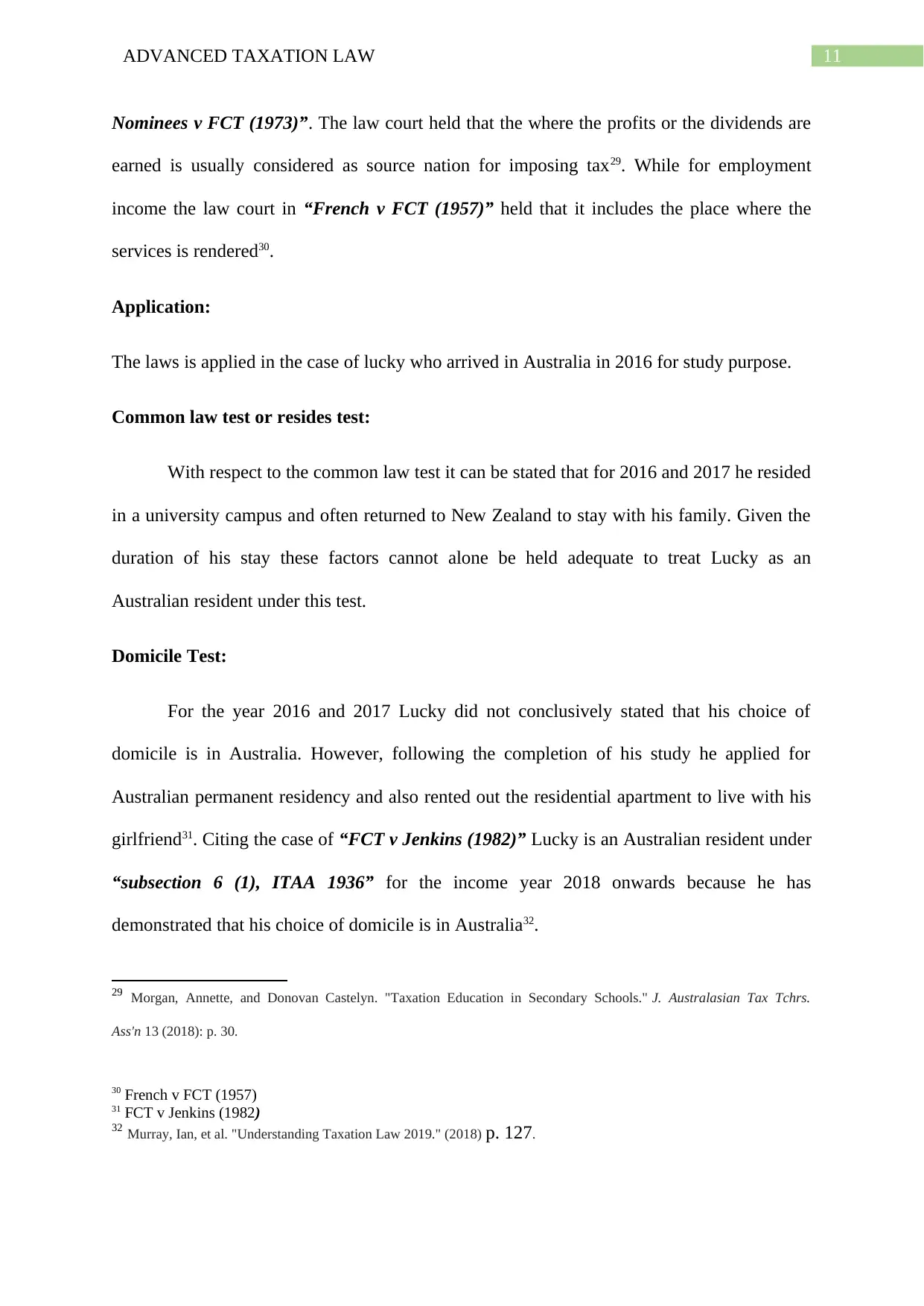
11ADVANCED TAXATION LAW
Nominees v FCT (1973)”. The law court held that the where the profits or the dividends are
earned is usually considered as source nation for imposing tax29. While for employment
income the law court in “French v FCT (1957)” held that it includes the place where the
services is rendered30.
Application:
The laws is applied in the case of lucky who arrived in Australia in 2016 for study purpose.
Common law test or resides test:
With respect to the common law test it can be stated that for 2016 and 2017 he resided
in a university campus and often returned to New Zealand to stay with his family. Given the
duration of his stay these factors cannot alone be held adequate to treat Lucky as an
Australian resident under this test.
Domicile Test:
For the year 2016 and 2017 Lucky did not conclusively stated that his choice of
domicile is in Australia. However, following the completion of his study he applied for
Australian permanent residency and also rented out the residential apartment to live with his
girlfriend31. Citing the case of “FCT v Jenkins (1982)” Lucky is an Australian resident under
“subsection 6 (1), ITAA 1936” for the income year 2018 onwards because he has
demonstrated that his choice of domicile is in Australia32.
29 Morgan, Annette, and Donovan Castelyn. "Taxation Education in Secondary Schools." J. Australasian Tax Tchrs.
Ass'n 13 (2018): p. 30.
30 French v FCT (1957)
31 FCT v Jenkins (1982)
32 Murray, Ian, et al. "Understanding Taxation Law 2019." (2018) p. 127.
Nominees v FCT (1973)”. The law court held that the where the profits or the dividends are
earned is usually considered as source nation for imposing tax29. While for employment
income the law court in “French v FCT (1957)” held that it includes the place where the
services is rendered30.
Application:
The laws is applied in the case of lucky who arrived in Australia in 2016 for study purpose.
Common law test or resides test:
With respect to the common law test it can be stated that for 2016 and 2017 he resided
in a university campus and often returned to New Zealand to stay with his family. Given the
duration of his stay these factors cannot alone be held adequate to treat Lucky as an
Australian resident under this test.
Domicile Test:
For the year 2016 and 2017 Lucky did not conclusively stated that his choice of
domicile is in Australia. However, following the completion of his study he applied for
Australian permanent residency and also rented out the residential apartment to live with his
girlfriend31. Citing the case of “FCT v Jenkins (1982)” Lucky is an Australian resident under
“subsection 6 (1), ITAA 1936” for the income year 2018 onwards because he has
demonstrated that his choice of domicile is in Australia32.
29 Morgan, Annette, and Donovan Castelyn. "Taxation Education in Secondary Schools." J. Australasian Tax Tchrs.
Ass'n 13 (2018): p. 30.
30 French v FCT (1957)
31 FCT v Jenkins (1982)
32 Murray, Ian, et al. "Understanding Taxation Law 2019." (2018) p. 127.
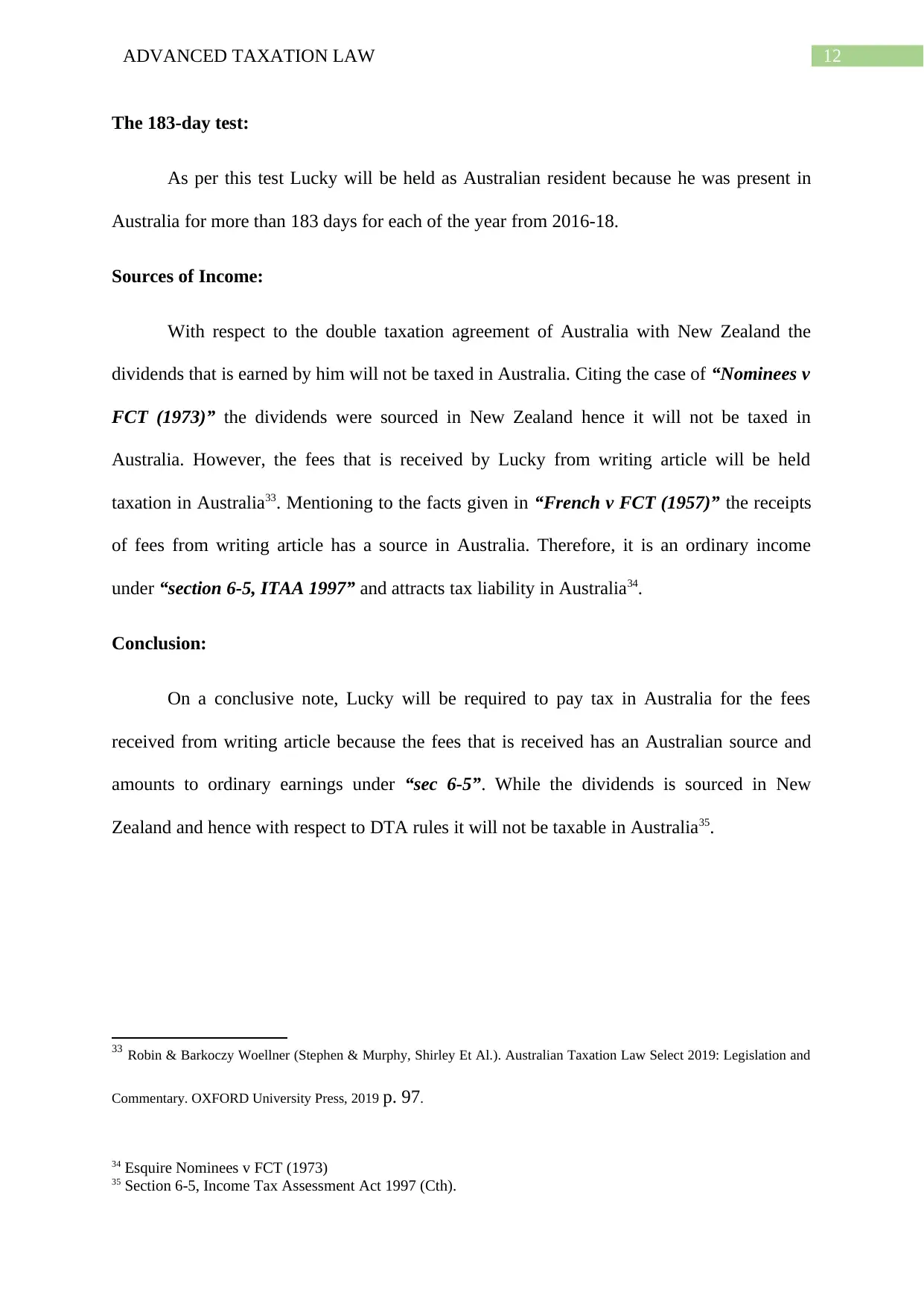
12ADVANCED TAXATION LAW
The 183-day test:
As per this test Lucky will be held as Australian resident because he was present in
Australia for more than 183 days for each of the year from 2016-18.
Sources of Income:
With respect to the double taxation agreement of Australia with New Zealand the
dividends that is earned by him will not be taxed in Australia. Citing the case of “Nominees v
FCT (1973)” the dividends were sourced in New Zealand hence it will not be taxed in
Australia. However, the fees that is received by Lucky from writing article will be held
taxation in Australia33. Mentioning to the facts given in “French v FCT (1957)” the receipts
of fees from writing article has a source in Australia. Therefore, it is an ordinary income
under “section 6-5, ITAA 1997” and attracts tax liability in Australia34.
Conclusion:
On a conclusive note, Lucky will be required to pay tax in Australia for the fees
received from writing article because the fees that is received has an Australian source and
amounts to ordinary earnings under “sec 6-5”. While the dividends is sourced in New
Zealand and hence with respect to DTA rules it will not be taxable in Australia35.
33 Robin & Barkoczy Woellner (Stephen & Murphy, Shirley Et Al.). Australian Taxation Law Select 2019: Legislation and
Commentary. OXFORD University Press, 2019 p. 97.
34 Esquire Nominees v FCT (1973)
35 Section 6-5, Income Tax Assessment Act 1997 (Cth).
The 183-day test:
As per this test Lucky will be held as Australian resident because he was present in
Australia for more than 183 days for each of the year from 2016-18.
Sources of Income:
With respect to the double taxation agreement of Australia with New Zealand the
dividends that is earned by him will not be taxed in Australia. Citing the case of “Nominees v
FCT (1973)” the dividends were sourced in New Zealand hence it will not be taxed in
Australia. However, the fees that is received by Lucky from writing article will be held
taxation in Australia33. Mentioning to the facts given in “French v FCT (1957)” the receipts
of fees from writing article has a source in Australia. Therefore, it is an ordinary income
under “section 6-5, ITAA 1997” and attracts tax liability in Australia34.
Conclusion:
On a conclusive note, Lucky will be required to pay tax in Australia for the fees
received from writing article because the fees that is received has an Australian source and
amounts to ordinary earnings under “sec 6-5”. While the dividends is sourced in New
Zealand and hence with respect to DTA rules it will not be taxable in Australia35.
33 Robin & Barkoczy Woellner (Stephen & Murphy, Shirley Et Al.). Australian Taxation Law Select 2019: Legislation and
Commentary. OXFORD University Press, 2019 p. 97.
34 Esquire Nominees v FCT (1973)
35 Section 6-5, Income Tax Assessment Act 1997 (Cth).
1 out of 13
Related Documents
Your All-in-One AI-Powered Toolkit for Academic Success.
+13062052269
info@desklib.com
Available 24*7 on WhatsApp / Email
![[object Object]](/_next/static/media/star-bottom.7253800d.svg)
Unlock your academic potential
© 2024 | Zucol Services PVT LTD | All rights reserved.





